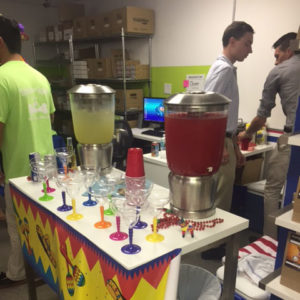Everyday Practices to Prevent Workplace Burnout
Easy Steps of Preventing Burnout in the Workplace
The American work-grind is a thrilling ride. Whether you are a CEO of a Fortune 500 company, or an eager entrepreneur getting a start-up off the ground, the business-hustle has an energy-fueled fervor that is addicting. We push ourselves to keep performing. Seeing hard work translate into success is addicting. We take pride in our achievements—the product of 12 hour days, ingenuity, and drained coffee mugs. At some point in the ascension, we all risk hitting a wall. The lingering thought in the back of the mind is preventing burnout.
Humans can only sustain a ‘tour de force’ drive for so long before burning out. Stress, sleep deprivation, and the lack of healthier lifestyle choices that gave way to working leads to 120,000 deaths each year.. The same study showed that $190 billion a year goes toward covering the health care costs of stressful jobs.
A separate study found that 44% of workers state that their current job is having an impact on their overall health. 43% report that their job has a negative impact on their levels of stress. Respondents stated that workforce pressure swayed them from taking vacation time, made them apprehensive about job security, or had significant issues keeping up with the demands of their workload.
*This polling was initiated by NPR, Robert Wood Johnson Foundation, and Harvard T.H. Chan School of Public Health and a research paper published by Harvard Business School and Stanford University’s Graduate School of Business.
Know the Signs of Burnout
I know this sounds like a cliche HR formality but knowing the symptoms of burning out can help you gauge your limits and prevent fatigue. A psychologist from the University of California named Christina Maslach developed what’s referred to as the Maslach Burnout Inventory. This can be used as a diagnostic tool to indicate when it’s time to ‘slow down.’ This inventory has three dimensions:
Emotional Exhaustion—Feelings of hollowness, depression, or being spent up both physically and mentally. Changes in personality and continued irritation also meet this criterion.
Depersonalization—Alienation from colleagues and friends occurs. Being unable to empathize with others and feeling a prolonged disconnection.
Reduced Personal Accomplishment—One’s capacity to perform is undermined. Loss of self-confidence resulting in one’s work performance suffering.
Burning out is separate from the typical workplace grumblings or feelings of occasional sadness. These symptoms are recurrent. Burnout happens when a person has passed the threshold of their professional capacity. If you are feeling any of these mental and physical inhibitions and leave them unattended, workplace stress can manifest itself into depression or anxiety.
Symptoms of Depression:
- Insomnia
- Engaging in Daily Functioning
- Problems Getting Out of Bed/Awakening in the Morning
- Extreme Sadness
- Loss of Appeal to Usual ‘Fun’ Activities
Symptoms of Anxiety:
- Racing Thoughts
- Racing Heart
- Stomach Issues
- Difficulty Concentrating
If any of these symptoms are controlling your work-experience or impeding on your life, consider scheduling an appointment with a physician.
Escape Technology
There are many factors involved when it comes to determining the culprit of burnout. In the modern office, technology almost certainly plays a role. Sitting for 8 plus hours a day staring at a computer screen is not an ideal situation for a human. Still, this is a reality. In the office, there are some practical steps one can take to make your workflow easier on the body.
- If you work on a computer, download f.lux. This software adapts your computer display brightness to the time of the day. At 9 a.m. your computer screen mimics sunlight as it monitors the amount of blue light radiating from your screen. Gradually, as the day goes on, the lighting of your computer screen gets warmer. This supports a healthy circadian rhythm and melatonin levels needed for good sleep.
- Maintaining proper posture at your desk is also important. Make sure the chair you sit in every day aligns properly to your spine. Every few hours it’s good to get up and get the blood flowing to the brain. Stretch, drink water, and then get back to your work.
- You should also set parameters for yourself. This regulates the active inputs in your life. For instance, after 7 p.m. you will not respond to emails or take business phone calls. Separating your personal life from your work life can help you recharge.
Actionable Steps Toward Healthy Work-Life Balance
Everyone has their own personal ways of preventing burnout. Some practice yoga or work out while others binge on Netflix. The trick is to have a life outside of work that is just as rewarding as your career achievements. Work-life balance is one of the most applicable ways to maintain a healthy life outlook. How do you get most out of the time spent away from work projects?
- Learn Something New. A good step toward fostering your entrepreneurial spirit and staying healthy is committing to learning something new every day. You can do this by reading books that interest you. Speaking with your mentors or even learning a musical instrument or new language is practical, fun, and keeps the mind sharp.
- Take personal time. Whether it is stepping away from the grind and taking a vacation, going to a spa day, or catching up with friends—find something that you enjoy and immerse yourself in it for a little while before returning back to work. When you get back to the office you’ll be surprised how refreshed you feel.
- Meditating. Taking a few minutes a day to clear your mind is both physically and mentally therapeutic. Going to a meditation class is a great de-stressor. Even taking a five-minute head-clearing walk can be helpful. Many busy workers have discovered Headspace—a meditation app for mindfulness training. Figure out what works for you.
- Service to others. Once you’ve rested, you might find that doing some volunteer work on the weekend helps you replenish energy levels. Make sure you’re in a good state to volunteer and work with others first, then try pursuing some philanthropic activities.
- Positivity. It’s an old cliche but it’s real. When you get home from work, think about the positive things that happened that day. Instead of worrying about the report due tomorrow, focus on what you accomplished today.
When It’s time to Notify Management
If you are having severe symptoms of fatigue, depression, or feel too burnt out to cope, it is better to be proactive about the situation than to let it get worse.
Reaching out to management is not alarming. A good manager should be considered and will help assist with workloads or time-off to help you recuperate. If feelings of burnout are deriving from feeling unappreciated at work or being detached from the team, talk to your manager about how your efforts help meet company objectives.
We hope you found this article helpful! Good luck with preventing burnout and maintaining that perfect harmony between your work and your life!
Follow Splash and Dash Groomerie & Boutique:
- Website: http://splashanddashfordogs.com/
- Website: https://splashanddashfranchise.com/
- Facebook: https://www.facebook.com/splashanddashfordogs/
- Instagram: @splashanddashfordogs
- LinkedIn: https://www.linkedin.com/in/dan-j-barton-622ab517
- Twitter: splashanddash4dog



